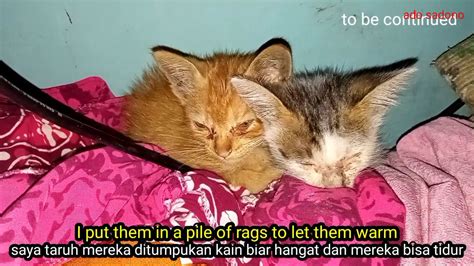
A video of a small, orange kitten attempting to playfully fight inanimate objects twice its size has gone viral, charming viewers with its determined, albeit clumsy, efforts. The kitten’s feisty but ultimately unsuccessful sparring attempts have garnered millions of views across social media platforms, turning the tiny feline into an internet sensation.
The viral video, shared widely on platforms like X (formerly Twitter), TikTok, and Instagram, features the orange tabby kitten engaging in a series of mock battles with various household items. These include a plush toy, a footstool, and even a small blanket, each encounter resulting in the kitten being comically outmatched. Despite its size disadvantage, the kitten displays relentless enthusiasm, jumping, swatting, and hissing with unwavering determination, endearing itself to online audiences worldwide.
“The internet is going crazy over a tiny orange kitten who is trying to fight things twice its size,” reported one social media user, reflecting the general sentiment of amusement and affection towards the diminutive warrior. The video’s popularity highlights the enduring appeal of animal content, particularly those showcasing humorous or heartwarming moments. The kitten’s spirited attempts, combined with its undeniably cute appearance, have proven to be a winning formula for viral success.
The origins of the video remain somewhat unclear, with various accounts reposting the content without definitive attribution to the original creator. However, the widespread sharing and reposting have only amplified its reach, exposing the adorable kitten to an ever-growing audience. Comments sections across different platforms are flooded with expressions of endearment, humorous observations, and personal anecdotes about similar experiences with their own pets.
One user commented, “This is exactly what my cat did when he was a kitten! They think they’re so tough,” while another added, “I can’t stop watching this! The determination in that little face is just priceless.” The shared experiences and relatable behaviors of the kitten contribute to its viral appeal, fostering a sense of community among viewers.
The internet’s obsession with animal videos is well-documented, with countless examples of cats, dogs, and other creatures achieving viral fame for their antics. This latest instance underscores the power of animal content to evoke positive emotions, provide lighthearted entertainment, and unite people across geographical boundaries. The “Tiny Tiger Fail” serves as a reminder of the simple joys that animals bring to our lives, offering a welcome distraction from the often-serious nature of online discourse.
Experts in animal behavior suggest that the kitten’s playful aggression is a natural instinct, particularly common in young cats as they develop their hunting skills and establish their place within their environment. The exaggerated movements and vocalizations are part of a learning process, helping the kitten refine its coordination and social interactions. While the kitten may not pose a genuine threat to its inanimate adversaries, the exercise is crucial for its physical and mental development.
Dr. Emily Carter, a veterinarian specializing in feline behavior, explained, “Play aggression is a normal part of kitten development. They’re practicing their hunting skills, learning about their environment, and figuring out how to interact with objects and other animals. It’s important to provide them with appropriate outlets for this behavior, such as toys and scratching posts, to prevent them from directing their aggression towards people or furniture.”
The viral video has also sparked discussions about responsible pet ownership, with some users cautioning against encouraging aggressive behavior in pets, even in a playful context. While the kitten’s antics are undoubtedly amusing, it’s important to ensure that its playful aggression doesn’t escalate into problematic behavior as it grows older. Providing ample opportunities for exercise, mental stimulation, and positive reinforcement can help shape the kitten’s behavior and ensure a harmonious relationship between pet and owner.
Animal shelters and rescue organizations have also seized on the video’s popularity to raise awareness about the importance of pet adoption and responsible breeding practices. The demand for kittens and puppies often leads to unethical breeding practices, resulting in health problems and overpopulation issues. By adopting from shelters or reputable breeders, prospective pet owners can help combat these problems and provide loving homes for animals in need.
The “Tiny Tiger Fail” phenomenon is a testament to the internet’s capacity to elevate ordinary moments into viral sensations. The kitten’s spirited but ultimately unsuccessful fight attempts have resonated with millions of viewers, offering a brief respite from the complexities of modern life and reminding us of the simple joys that animals can bring. As the video continues to circulate across social media platforms, the tiny orange tabby remains a symbol of determination, resilience, and the enduring power of cuteness.
The impact of the video extends beyond mere entertainment. It has triggered conversations about animal behavior, responsible pet ownership, and the role of animal content in shaping online culture. The kitten’s viral fame serves as a reminder of the interconnectedness of our digital world and the ability of a single, heartwarming moment to unite people from all walks of life. The video’s success also highlights the potential for animal content to be used for positive purposes, such as promoting animal welfare and raising awareness about important issues.
In conclusion, the “Tiny Tiger Fail” is more than just a viral video; it’s a cultural phenomenon that reflects our shared love of animals, our appreciation for humor, and our desire for connection in an increasingly digital world. The orange kitten’s spirited attempts to conquer its inanimate foes have captured the hearts of millions, proving that even the smallest among us can achieve great things, at least in the eyes of the internet. The video underscores the internet’s power to create viral sensations from the most unexpected sources. The kitten’s earnest efforts to take on objects much larger than itself have struck a chord with viewers worldwide, leading to widespread sharing and commentary.
The video’s success is also a reminder of the power of humor and relatability. Many pet owners have shared stories of their own pets exhibiting similar behaviors, creating a sense of community and shared experience. The comments sections of various platforms are filled with anecdotes and observations, highlighting the common thread of affection and amusement that animals inspire in us.
One aspect of the viral video that has generated significant discussion is the issue of anthropomorphism. While it’s natural to project human emotions and motivations onto animals, it’s important to recognize the limitations of this approach. Attributing complex emotions to the kitten based solely on its behavior can lead to misunderstandings and misinterpretations. However, the human tendency to anthropomorphize animals is a deeply ingrained aspect of our relationship with them, and it often plays a role in how we perceive and interact with our pets.
The “Tiny Tiger Fail” video has also prompted reflection on the nature of viral content itself. In an era of information overload and constant connectivity, it’s often difficult to predict what will capture the public’s attention. The kitten’s video is a reminder that simple, heartwarming content can often cut through the noise and resonate with a wide audience. The video’s success is also a testament to the power of visual storytelling. The kitten’s antics are inherently engaging, and the video’s concise format makes it easily shareable across various platforms.
From a marketing perspective, the “Tiny Tiger Fail” video offers valuable insights into the dynamics of viral marketing. The video’s organic reach and widespread sharing demonstrate the power of authentic content to generate engagement and build brand awareness. While it’s impossible to replicate the success of a viral video intentionally, marketers can learn from the elements that made the “Tiny Tiger Fail” so successful, such as its humor, relatability, and visual appeal.
In addition to its entertainment value, the “Tiny Tiger Fail” video also has educational potential. Animal behaviorists can use the video as a teaching tool to illustrate concepts such as play aggression, socialization, and the development of motor skills in kittens. The video can also be used to promote responsible pet ownership and raise awareness about the importance of providing animals with appropriate care and enrichment.
The story also highlights the impact of social media on animal welfare. In recent years, social media platforms have become powerful tools for animal rescue organizations and advocacy groups. By sharing stories and videos of animals in need, these organizations can raise awareness about animal cruelty, promote adoption, and mobilize support for animal welfare initiatives. The “Tiny Tiger Fail” video is a reminder of the potential for social media to be used as a force for good in the animal welfare community.
In conclusion, the “Tiny Tiger Fail” video is a multifaceted phenomenon that reflects our shared love of animals, our appreciation for humor, and our increasingly interconnected digital world. The kitten’s spirited attempts to conquer its inanimate foes have captured the hearts of millions, and the video’s success has sparked conversations about animal behavior, responsible pet ownership, and the nature of viral content itself. The video serves as a reminder of the power of simple, heartwarming moments to unite people and bring joy to our lives. The internet, it appears, has an endless appetite for adorable animal antics, and this tiny tiger certainly delivered. Its viral success demonstrates the enduring power of animals to entertain and uplift us. The video is a perfect example of how a simple, unscripted moment can capture the internet’s imagination and generate a wave of positive emotions.
The widespread attention has also led to increased interest in adopting orange tabby kittens, with animal shelters reporting a slight uptick in inquiries about similar-looking felines. This “Tiny Tiger effect” underscores the potential for viral content to influence consumer behavior and promote positive outcomes, such as pet adoption. While the long-term impact of the video remains to be seen, its immediate effect has been undeniably positive, bringing joy to millions and sparking conversations about the importance of animal welfare.
The fact that the kitten’s attempts are ultimately unsuccessful only adds to the humor and endearment. Viewers appreciate the kitten’s unwavering spirit, even in the face of overwhelming odds. This resonates with our own experiences of facing challenges and overcoming obstacles, albeit on a much grander scale. The kitten’s persistence serves as a reminder that even small acts of defiance and determination can be inspiring.
The video’s virality also speaks to the power of visual storytelling. In a world saturated with information, videos have become an increasingly effective way to capture and hold people’s attention. The “Tiny Tiger Fail” video is a prime example of how a simple, well-executed visual narrative can resonate with a wide audience and generate a significant impact. The video’s success is a testament to the power of visual media to connect people and create shared experiences. The ability to witness the kitten’s antics firsthand, rather than simply reading about them, enhances the emotional impact and makes the video all the more memorable. The video’s simple, yet engaging, format makes it easily digestible and shareable across various platforms.
As the video continues to circulate, it’s likely to inspire even more interpretations and analyses. The “Tiny Tiger Fail” has already become a cultural touchstone, representing the power of animals to bring joy and connect people in a digital age. Its success is a reminder that even the smallest among us can have a big impact, and that sometimes, the most endearing moments are the ones that involve a little bit of failure. The video also brings up the question of whether such videos lead to unrealistic expectations from pet owners when they adopt kittens.
In an era often characterized by division and negativity, the “Tiny Tiger Fail” serves as a welcome reminder of the things that unite us. The shared love of animals, the appreciation for humor, and the desire for connection are all powerful forces that can transcend cultural and geographic boundaries. The video’s success is a testament to the enduring power of these forces, and a reminder that even in the darkest of times, there is always room for a little bit of light and laughter.
The “Tiny Tiger Fail” is not just a viral video; it’s a cultural phenomenon that speaks to our shared humanity. The kitten’s antics have captured the hearts of millions, reminding us of the simple joys of life and the power of animals to bring us together. As the video continues to circulate, it’s likely to inspire even more interpretations and analyses, solidifying its place in the annals of internet history. The viral nature of the video also highlights the importance of online safety and responsible sharing practices.
Frequently Asked Questions (FAQ)
1. What exactly happens in the “Tiny Tiger Fail” video?
The video features a small, orange tabby kitten attempting to playfully fight objects much larger than itself, such as a plush toy, a footstool, and a blanket. Despite its efforts, the kitten is comically outmatched in each encounter, but its determination and spirited attempts have charmed viewers worldwide. The kitten jumps, swatting with its paws, and hissing adorably, creating a funny and heartwarming scene.
2. Why has this video gone viral?
Several factors contribute to the video’s viral success. The kitten’s small size and cute appearance are inherently appealing. Its determined yet unsuccessful attempts to fight larger objects are humorous and relatable. The video provides a brief, lighthearted escape from the stresses of daily life, offering a dose of positivity and entertainment. The shared human experience of watching an underdog persist, even when facing impossible odds, also contributes to the video’s widespread appeal.
3. What does this video say about animal behavior?
Experts say the kitten’s behavior is normal play aggression, a natural part of kitten development as they hone their hunting skills and learn to interact with their environment. Play aggression allows kittens to refine their coordination and social skills in a safe and playful manner. It is essential for kittens to have appropriate outlets for this behavior, such as toys, to prevent them from misdirecting their aggression towards people or furniture.
4. How can pet owners ensure that play aggression doesn’t become a problem?
Pet owners can manage play aggression by providing ample opportunities for exercise, mental stimulation, and positive reinforcement. Engaging kittens with interactive toys, such as laser pointers or feather wands, can help them channel their energy in a constructive way. Scratching posts and climbing structures also provide outlets for their natural instincts. Consistent training and positive reinforcement can help shape the kitten’s behavior and prevent it from becoming problematic as it grows older.
5. What are the potential negative impacts of viral animal videos?
While viral animal videos can be entertaining, they can also contribute to unrealistic expectations of pet ownership. Some viewers may be inspired to acquire pets based on these videos without fully considering the responsibilities involved. Increased demand for certain breeds or types of animals can also lead to unethical breeding practices, resulting in health problems and overpopulation issues. Viral videos can sometimes encourage irresponsible behaviors, such as the mistreatment of animals for entertainment purposes. It is essential to view such videos with a critical eye and to prioritize animal welfare at all times.









